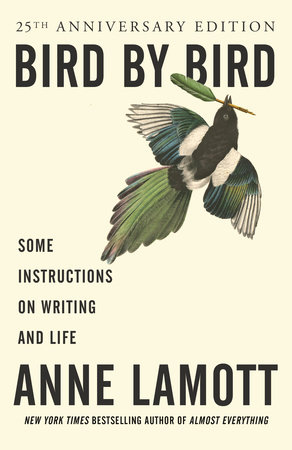
Anne Lamott’s Bird By Bird: Some Instructions on Writing and Life has long been one of the most celebrated books for writers (beginners and otherwise). I have referenced it in my own writing lists, and occasionally skimmed it. I’ve only recently read the entire book, as the book group I belong to made it our choice for this month and will meet to discuss it next week. Coincidentally, it was published in 1994, the year I joined the group.
Matt Haig, the wildly popular British author of The Midnight Library and other bestsellers, responded to a 2020 query from The Washington Post about books he planned for holiday giving that year. Bird by Bird, Haig said, “is my go-to gift or recommendation for anyone interested in writing, though it is as much a treatise on life as it is a creative-writing primer.”
I can see why it remains a big hit with staying power. Lamott’s sage, funny, and not-mincing-words style will never go out of fashion. It honors the psychological framework of the writing and publication process. And she is honest and forthcoming about her own disappointments, difficulties with writing, and candid about her relationships with her fellow authors.
As is suggested by the subtitle, this is partly a somewhat spiritual self-help book. It emphasizes that while writing is ultimately a solitary and often lonely act, we can’t forget that other people are involved, and not just readers, editors, and publishing-related professionals. There is a crucial role for friends, family, writing groups, teachers, and students.
It is partly based on a writing course Lamott taught in California in the decade before the book was published. Although she had not written a book about writing, she had already published several books. The paperback I read is marked as the “25th anniversary edition,” with a different cover. But there does not seem to be any different, or added content from the original. Maybe that is just as well, because in some sense the book is frozen in time in 1994, and since her advice is timeless and universal, we don’t particularly need it to seem up to date. I enjoyed its time capsule effect.
Even though the world has drastically changed since the book’s initial publication, her portrait of the pleasures and pains of the writing life remains valid. That is an accomplishment, considering the huge changes affecting writing, publishing, and book selling that either were just starting to happen or had not yet happened in 1994. Any truly updated edition of her book would have to somehow incorporate the effects of those changes, and it would make Bird by Bird into a much different book.
Amazon was formed in the middle of that year. Blogging as we know it did not exist, and the term was not in use until much later in the decade. The World Wide Web was in its infancy, and most people had not heard of it. Google would not exist for another four years. Cell phones were not in widespread use; and it would be another 13 years until the appearance of the iPhone. We were far from the creation of social media. Most people did not use email. It would be seven more years until 9/11.
Somehow it seems that Bird by Bird is better for not having to incorporate all these changes, or the rise of self-publishing, hybrid publishing, e-books/Kindles, and the rise and sophistication of audiobooks (rather than the ‘books on tape’ of that era). Yet despite those changes, and considering how nearly apocalyptic things may seem in 2022, consider these words from “The Last Class,” the final, Part Five of the book: “The society to which we belong seems to be dying or is already dead. I don’t mean to sound dramatic, but clearly the dark side is rising. Things could not have been more odd and frightening in the Middle Ages.”
And although it is primarily focused on writing fiction, the book remains relevant for nonfiction writing; especially the concepts of initially drafting material (even if it is inferior) in the smallest possible units to get something on paper (or on screen) that you can edit later. On page 107 she advises: “Writing is about hypnotizing yourself into believing in yourself, getting some work done, then unhypnotizing yourself and going over the material coldly.”
Lamott remains a best-selling author with 19 fiction and nonfiction titles in print. Bird by Bird is not even among the six book covers depicted on her Facebook page. She is candid in its pages about her own life, and mistakes she’s made along the way, personally and professionally. Her storytelling is superb. Her sense of humor shines through, as does a winning self-deprecation.
She discusses how she interacts with her students, and how frustrating that can be when they are too impatient to properly learn the basics and mechanics of writing, and too quick to want to skip ahead to how to find an agent and publisher. “One of the things that happens when you give yourself permission to start writing,” according to Lamott on page 128, “ is that you start thinking like a writer. You start seeing everything as material.”
Also in “The Last Class,” Lamott reminds us why writers are so important, and why writing is worth the worries, problems, and frustrations: “Becoming a writer is about becoming conscious. When you’re conscious and writing from a place of insight and simplicity and real caring about the truth, you have he ability to throw the lights on for the reader. He or she will recognize his or her life and truth in what you say, in the pictures you have painted, and this decreases the terrible sense of isolation that we have all had too much of.”
